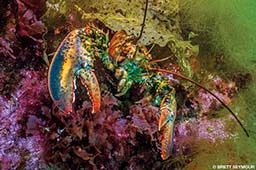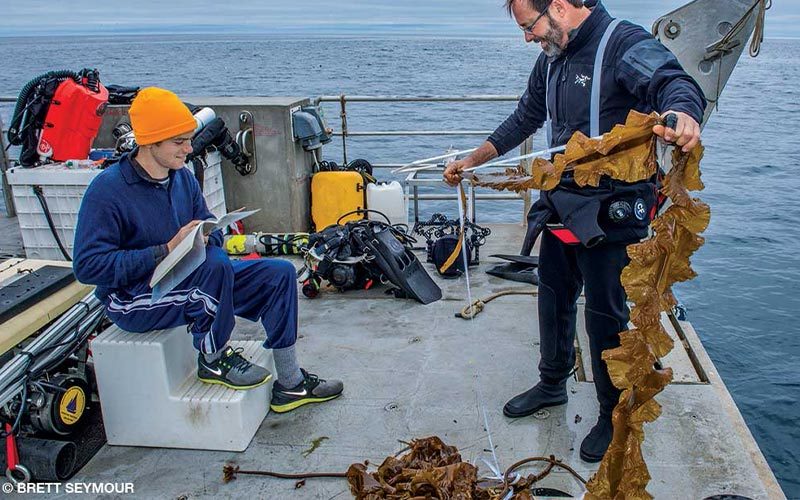Off the coast of New England, 80 miles from Cape Ann, Mass., lies an anomaly. An ecosystem that is unexpected, beautiful and unrivaled in the North Atlantic exists there — it would seem less out of place in the Caribbean or amid the kelp forests of the West Coast. Fisheries biologists and fishermen have long been aware of its existence because the rich ecosystem serves as a nursery for many species of fish, most notably North Atlantic cod. It is one of the few places on the East Coast considered by scientists to be unique, flourishing and in need of permanent protection. Dubbed “the Yellowstone of the North Atlantic” and designated a Hope Spot by Sylvia Earle, the underwater mountain range called Cashes Ledge is a place that should be on everyone’s radar, both as a one-of-a-kind dive spot and, I hope, the first Marine National Monument in the Atlantic.

Several years ago my friend Luis Lamar, a cinematographer, came back from an expedition with National Geographic photographer Brian Skerry to document an underwater mountain range in New England that very few people knew existed. Lamar spoke of mesmerizing kelp, caves filled with lobster, and schools of fish unlike anything we had seen in the area before. He spoke softly and eloquently, almost reverently, about Cashes. The trip had been sponsored by the Conservation Law Foundation (CLF), which seeks to photograph and protect unique and beautiful places around New England. Fortunately for me more trips were in the works, and they wanted to expand the underwater efforts to include high-resolution 4K video.
Getting to Cashes Ledge is an adventure unto itself. Diving nearly 100 miles off shore from relatively small boats can be a challenge and not suitable for those with delicate stomachs. Fortunately for our dive team, Priscilla Brooks, CLF’s vice president and director of ocean conservation, had chartered the RV Tioga from Woods Hole Oceanographic Institution, and it made a wonderful dive platform. Most important, it cruised at 16 knots, which allowed the team to sneak in dives whenever an appropriate weather window presented itself, which was not very often. South of Newfoundland’s Grand Banks and still susceptible to many of the weather patterns that can create very dangerous conditions (remember The Perfect Storm?), we spent many days waiting. Over three years of diving, we made it out on only six of the approximately 30 potential days and were rarely out for more than a single overnight at a time. But in the many hours of sitting at the dock or in a quaint little home in York Harbor, Maine, I met and listened to a passionate coastal biologist who has become the heart and soul of Cashes Ledge: Brown University biology professor Jon Witman, Ph.D.
Cashes Ledge would likely be little more than a name on the charts if not for Witman. He and his team began diving and studying the biodiversity there in the 1980s, and what they found astounded them. They likened it to a time capsule from the 17th century — the cod were often as big as divers and were more plentiful there than anywhere else they had studied — as plentiful as in some of the early Pilgrim settlement accounts.

Compared with other coastal regions in the 1980s, Cashes Ledge was an outlier, in a good way, and word soon got out. By the late 1990s destructive fishing practices had devastated the area, and fish populations were collapsing. Laudably, the New England Fishery Management Council (NEFMC) imposed a ban on the most detrimental practices — bottom trawling and dredging — though it left the area open to others such as midwater trawling. With the ban in place, the populations have slowly started to rebound.
Hearing Witman tell stories about Cashes Ledge in the ’80s — when schools of cod, pollock, cunner and other fish could be seen with myriad sharks, whales and other pelagics among the kelp — was both poetic and disheartening. He had the privilege of studying Cashes in its modern heyday, and he helplessly watched its subsequent destruction to the brink of collapse. Now he is documenting and quantifying its recovery with the help of CLF. The recovery, however, is not guaranteed; the ledge could be opened to all fishing and other exploitative activities at any time. CLF’s mission was clear: They wanted to showcase the underwater world through imagery to reveal the magic of the ledge today and its potential for tomorrow.
Diving Cashes Ledge had been built up so much in my mind by Lamar, Skerry, Brooks and Witman that I was afraid it might be a letdown, like so many underwater places are these days. But it was a surreal dream of swaying kelp, playful cod, schools of pollock skirting the edge of vision and scenes of life I could barely have imagined. My eyes never left the camera screen, and before I knew it I found myself beneath the kelp, filming its soothing dance backlit by the blue-green sea. I was rolled and tossed among its long golden-red stalks in harmony with their ebb and flow. In a blink it was time to ascend. Wide-eyed and transformed I surfaced, and for the first time ever I felt a need — an obligation — to help protect a place.

I asked Witman and his collaborator, Robbie Lamb, for bullet points about why, from a scientific point of view, Cashes should be protected. One thing in particular stuck out to me: Cashes Ledge currently has 500 times the fish biomass of any other nearby coastal site. That’s a figure that should be incredible to anyone who has dived in New England and wondered where the fish are and, most important, where fish will come from in the future. When I first dived the ledge and saw all the tiny mussels and fish under the kelp, I thought of a nursery, and in many ways that is what Cashes is for its resident species. Perhaps a more important question is why so many adult fish remain there. Certainly the lack of fishing over the past 15 years has helped, but in other areas with the same type of protection the results are not the same.
What sets Cashes apart is its extraordinarily high density and sheer biomass of kelp — 50 times that of other nearby coastal areas. It is continually fed by cool, nutrient-rich water generated by a standing wave that occurs with great regularity at the site. This wave has been called a productivity engine; it creates constant upwelling and changes the water from cool with good visibility to warm with reduced visibility. It can be a strange and disorienting yet marvelous part of diving here. As the kelp thrives, it provides food and protection for the many fish that call it home. Then during its seasonal die-off, the detritus feeds species deeper in the water column.
Marine mammals of all sorts flock to the ledge, and there is evidence that it may even be a breeding ground for the highly endangered North Atlantic right whale. On any given day on the ledge you might encounter five or six different whales, schools of dolphin and even basking sharks. At the end of diving days we often wondered what was more unbelievable: the growing schools of cod and pollock playing in the kelp or the whales and dolphins feeding all around us on the surface?

As magnificent as Cashes is, it still has a long way to go. The fish populations are nowhere near where they were when Witman started studying them in the 1980s. Cod, which fed the United States and Europe for centuries, barely has a foothold on the ledge, especially when compared to historical numbers. The NEFMC ban has proven that Cashes has the ability to rebound, but scientists the world over have shown that permanent areas of protection are essential if we want fish populations to thrive, especially in the context of heavy fishing pressure.
CLF continues to urge legislators for permanent protections at Cashes Ledge. One of the biggest challenges it faced in the past was trying to protect an area that no one had heard of. With incredible foresight and in the spirit of older journalistic traditions of using science and imagery to create a movement, the efforts of Brooks, Witman and Skerry on behalf of CLF are slowly making headway in the push for protection. Because of their tireless efforts and with a little help from the images and story our team created, many people are now aware of Cashes Ledge’s exquisite beauty and vital importance for our future fisheries.
Explore More
© Alert Diver — Q3 Summer 2016